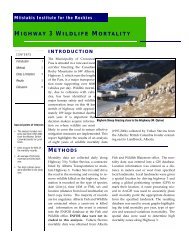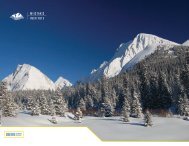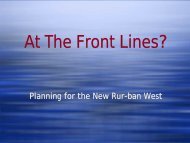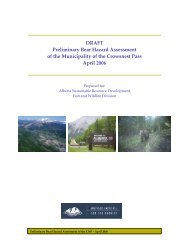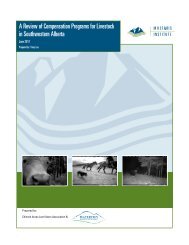A GIS based approach to restoring connectivity across Banff's Trans ...
A GIS based approach to restoring connectivity across Banff's Trans ...
A GIS based approach to restoring connectivity across Banff's Trans ...
You also want an ePaper? Increase the reach of your titles
YUMPU automatically turns print PDFs into web optimized ePapers that Google loves.
These wildlife crossing structures come in various<br />
shapes and sizes <strong>to</strong> attempt <strong>to</strong> meet the needs of the<br />
variety of species that frequent the area. Some species,<br />
such as grizzly bears and wolves, prefer large, open<br />
structures, while other species, like black bears and<br />
cougars, seem <strong>to</strong> prefer narrow, closed, dark structures<br />
that more accurately mimic their preferred habitats.<br />
Deer and elk prefer overpasses <strong>to</strong> underpasses<br />
(Clevenger and Waltho 2005).<br />
Poorly designed crossing structures, or well-designed<br />
crossing structures in the wrong locations, may preclude<br />
wildlife from using them. Indeed, the structural<br />
attributes of the crossing structures themselves tend <strong>to</strong><br />
be more important for both preda<strong>to</strong>r and prey species<br />
than are fac<strong>to</strong>rs related <strong>to</strong> landscape configuration and<br />
human use (Clevenger and Waltho 2005).<br />
Generally speaking, fencing has decreased wildlife<br />
mortality and crossing structures have allowed some<br />
animals <strong>to</strong> cross from one side <strong>to</strong> the other of what<br />
would otherwise have been a “Berlin Wall” for<br />
wildlife. Fencing on phases I, II and IIIA resulted in<br />
>80 percent decrease in wildlife roadkills,<br />
especially of ungulates (>95 percent).<br />
However, it is important <strong>to</strong> point out that fencing did<br />
not dramatically reduce vehicle-related mortality for<br />
all species. As a group, carnivores only saw a 16<br />
percent reduction in road-related mortality. Indeed,<br />
more black bears, cougars, and coyotes were killed on<br />
certain sections of highway (phases I, II, and IIIA;<br />
phase II; and phases I and II, respectively) after they<br />
were twinned and fenced (Clevenger et al. 2002). Such<br />
high rates of mortality on mitigated sections of<br />
highway can be attributed <strong>to</strong> the ease with which these<br />
animals can scale or jump over, or dig under the 2.4-<br />
metre fence (Golder 2004).<br />
Use of crossing structures was also species dependent.<br />
Moni<strong>to</strong>ring between 1997 and 2002 indicated that there<br />
were more than 8000 passages by wildlife at the 13<br />
crossing structures on Phase 3A. Deer used the crossing<br />
structures most frequently (3524), followed by elk<br />
(3268) and coyotes (985). Among large carnivores,<br />
cougars used the crossing structures most often (170),<br />
followed by black bears (142), wolves (132), and grizzly<br />
bears (25) (Clevenger et al. 2002). Wolverines were<br />
never documented using any of the crossing structures.<br />
West of Castle junction, the remnant two-lane unfenced<br />
portion of TCH (Phase IIIB) services daily <strong>to</strong>urists and<br />
trans-continental commercial traffic. This remaining 30<br />
km section of TCH in BNP (ending at Kicking Horse<br />
Pass), like other unmitigated highways in the area, poses<br />
genuine problems for wildlife movement within the<br />
Central Canadian Rocky Mountain region (Clevenger et<br />
al. 2002). The upper Bow Valley differs from the lower<br />
and middle sections of the Bow Valley where phases 1,<br />
2 and 3A are found. It is characterized by an assemblage<br />
of large mammal species with inherently low population<br />
densities, and more sensitive <strong>to</strong> human disturbance than<br />
typical fauna occupying the middle and lower Bow<br />
Valley (Stevens et al. 1996, Austin 1998, Apps 1999,<br />
Gibeau 2000, see review by Tremblay 2001).<br />
Key species <strong>to</strong> consider when designing Phase IIIB<br />
mitigation passages consist of wolverine, moose,<br />
lynx and grizzly bear, though cougars, wolves,<br />
black bears, marten, elk and deer also frequent the<br />
area. Meeting the needs of these species on Phase<br />
IIIB will require a mitigation strategy that provides<br />
for greater highway permeability, by incorporating<br />
more high quality wildlife crossing structures duly<br />
placed at more frequent intervals than in past<br />
twinning projects (Clevenger et al. 2002).<br />
PAGE 14<br />
IMPROVING CONNECTIVITY ACROSS BANFF’S TRANS-CANADA HIGHWAY



